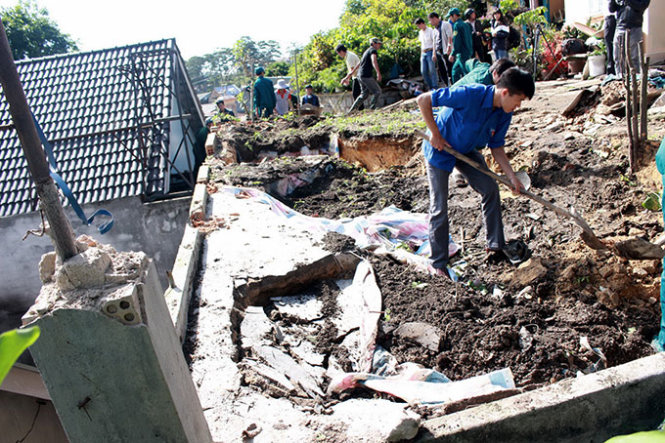Thousands of taluses, or sloping bases of housing fortifications, in Da Lat have incurred serious cracks and could give way at any time, posing serious hazards to residents and tourists.
>> An audio version of the story is available here
Houses nestled beneath the taluses found in abundance in Da Lat, the heart of Lam Dong Province in the Central Highlands, are considered “time bombs” for residents and tourists who may happen to be in the wrong place at the wrong time.
The hazards loom even larger now that the area has experienced relentless torrential rains in recent times.
Around 70-80 percent of structures in the city, including houses, villas and civil engineering works, feature the fortifications, which stand some five to 10 meters tall, according to Le Quang Trung, vice director of the provincial Department of Construction.
The fortifications, which are a special feature for buildings in the city, are meant to cement them in the hilly, sinuous terrain.
Constant perils
After a one-hour torrential downpour on Tuesday, Nguyen Duc Thiem, who resides in the Suoi Cat Tan An zone in Ward 3, detected a few minor cracks on the talus in front of his house.
The crevices were no serious cause for concern, as they have occasionally appeared over the last several years, Thiem said.
The talus in front of his house, which stands eight meters tall and measures 15 meters in length, was built by another person in the 1980s, he added.
In 2000, he had its foundation reinforced for the first time and was assured that such a cemented talus would never give way during rain.
To his family’s shock, around 5:30 pm on Wednesday, most of the talus collapsed onto two neighboring houses.
The entire structure crumbled by the end of the same day.
Vo Van Luyen, who has called the area beneath the talus home for almost 20 years, said he and his wife narrowly cheated death during the incident.

The talus collapse on May 6, 2015 sent rubble pounding onto Vo Van Luyen's house. Photo: Tuoi Tre
His family and other households have lived in constant fear for the past several years.
They make it a point to remind the talus owner to reinforce it before the rainy season begins every year.
In another incident, a 10-meter talus on Trieu Viet Vuong Street in Da Lat gave way without warning on Sunday, sending some 20 cubic meters of rubble down onto a seven-seat cab.
The cab was wrecked beyond recognition, but its driver was lucky not to be in the car at the moment of the collapse.

A 10-meter talus on Trieu Viet Vuong Street in Da Lat gave way without warning on May 3, 2015, sending some 20 cubic meters of rubble down onto a seven-seat cab. Photo: Tuoi Tre
Dao Duy Tu Street in Ward 4 has long been notorious for precipitous slopes and long taluses which crisscross the street’s every nook and cranny.
Le Van Nam, a resident whose house is adjacent to a talus towering some 15 meters, said the area is prone to minor erosions. To make matters worse, this fortification has no dykes at all.
Nam said in the worst case scenario, the fortification can crumble, plunging almost a dozen households into an abyss and causing untold damage and casualties.
Management difficulties
According to an official at the Da Lat People’s Committee, out of some 1,000 construction permits granted every year, about 20 percent incorporate the construction of taluses.
“Most of the current taluses have been in use for many years and gone without maintenance. Moreover, the unpredictable torrential rains in recent times have deprive many such structures of stability, making erosion inevitable,” the official explained.
Trung, vice director of the provincial Department of Construction, said buildings with imposing taluses, which stand roughly 15 meters tall and span between 200 and 300 meters, are basically safe thanks to regular maintenance and inspection.
However, it is an overwhelming challenge to properly inspect and protect thousands of such taluses from human and environmental impacts.
In several places, residents fail to clear the grooves on the talus surface, putting further weight on them and aggravating their risks of erosion.
Potentially insidious cracks which are only some millimeters in width generally go unnoticed by inhabitants as they are usually surfaced with moss.
Trung cautioned residents to promptly notify local construction inspecting units or the construction department’s Construction Inspection Center of fissured or overloaded taluses for timely intervention.
The department will adopt approaches to raise locals’ awareness of the issue in the time to come, he added.
Like us on Facebook or follow us on Twitter to get the latest news about Vietnam!




















































